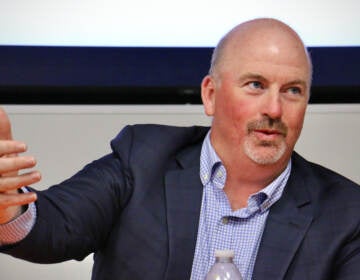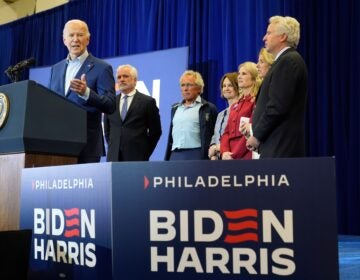Voters flock to chance to fix Philly’s election map
Unbelievable. More than 100 people showed up Monday night to register their views on how to redraw the city’s election map.
Color me amazed.
Set me down as stunned.
File me under “flabbergasted.”
Monday was a very muggy night in August, in the heart of the time when Philadelphia reconvenes down the Shore, or retreats to the Poconos.
And the topic of the night’s session was how to use a complex software application that enables you to draw lines on a map to meet a very fussy set of rules.
And for every person who might think of coming, you could find a hundred cynics in Philadelphia who would tell that showing up at WHYY’s Hamilton Public Media Commons on this night was a fool’s errand, that the fix is in and the public can’t do a damn thing about it.
Yet the room was filled, folks in suits, folks in T-shirts, young, old, professional, working class, black, white and Latino.
More than 100 people showed up at our place, because they’d like to have a real voice in drawing the map that will determine how City Council elections happen in Philadelphia for the next decade.
An onrushing deadline
Under the City Charter, Council members get to draw this map, which influences their own political fortunes. They face a Charter-dictated Sept. 9 deadline to get a map approved, which leaves precious little time for public input.
The crowd heard from Robert Cheetham and Abby Fretz of Azavea, the civic-minded software firm from Philly that’s been working nationally for years to give voters a set of tools to enable them to fight the gerrymander–those crazy-quilt election districts designed only to protect incumbents, with no regard to community of interest.
Azavea, working with WHYY/NewsWorks, the Daily News editorial board, Philly.com and the Penn Project for Civic Engagement, has created FixPhillyDistricts.com.
It’s a Web site where anyone with a working knowledge of Philly neighborhoods, a sense of how democracy could work in the city, and a little bit of patience, can create an election map for the city that will a) embody public values b) be better than the abortion that City Council produced in 2001.
Civic good, and prizes, too!
These partners are holding a contest, with $1,000 in prizes, for the best voter-drawn maps. The maps will be judged on how well they meet the goals of equal distribution of population among the 10 Council districts, compactness and reflecting community of interest.
The deadline for submitting a map is Aug. 28. You don’t have to use Azavea’s FixPhillyDistricts tool to do your map, but based on the demo last night, why wouldn’t you?
Folks heard Cheetham and Fretz report that the contest, even before this orientation session, had attracted more registered users (200), maps in progress (300) and valid map submissions (20) (corrected) than similar contests Azavea has been involved in out in California and Arizona, and in Virginia.
Philadelphians clearly want to do something to prevent City Council from producing a zany, self-interested election map that does nothing but confuse voters. Submissions can come from individuals or groups.
If you’d like to try your hand, but don’t feel comfortable working solo, e-mail me at csatullo@whyy.org and we’ll get you hooked up with a group that’s decided to craft a joint map.
Azavea will conduct webinars on how to use the tool at 6:30 p.m. this Thursday (Aug. 11) and 6:30 p.m. next Monday (Aug. 15). Sign up to take part at FixPhillyDistricts.com.
Getting Council to listen
The group heard Sandy Shea, editorial page editor of the Daily News, vow to do everything she could to persuade Council members to take citizen input seriously as they, and to be more transparent about how they are going about drawing the map.
“What software is Council using to this? How does it compare to Azavea’s? I would love to know,” she said. “We’ll try to find out for you.”
The group heard me quote Tug McGraw (“Ya gotta believe!”), Woody Allen (“Ninety percent of success in life is showing up.”) and political philosopher Michael Sandel (“Together we can come to find a wisdom we could not find alone.”)
And the group took part in a lively dialogue facilitated by Harris Sokoloff of the Penn Project for Civic Engagement. He made the key point that drawing an election map is not purely a technical exercise, or a magic trick.
The map you seek to draw depends on the values you seek to embody in those lines.
So he asked the group to discuss two questions: What doesn’t work in the current map? It we had a map that worked well, what values of ours would it advance?
What doesn’t work, and what might
Some of the feedback on what’s wrong:
The current map does not reflect neighborhood boundaries, in fact slices them up willy-nilly. It leaves many neighborhoods not knowing which Council person to call about an issue.
The lines are drawn to support the political ambitions of those who draw them. It’s a conflict of interest.
The map disenfranchises certain groups, making their votes count less.
It doesn’t correspond with federal and state election districts, reducing leverage.
It doesn’t correspond with other city boundaries–e.g. wards, police districts etc.
It’s neither successfully heterogenous or homogenous. In other words, it doesn’t mix neighborhoods of varying economic power well, nor does it combine similar neighborhoods in a way that enhances their voice.
And some of the aspirations for the next map:
Transparency. A process that people can understand, and a map that lets people know clearly who represents them.
A map drawn with constituents’ interest in mind, not incumbents.
Compact districts, that are easy to remember and reflect neighborhoods.
A map that makes every voter’s vote really count.
A map that enhances a sense of community among similar neighborhoods.
A map that respects the integrity and reach of vital neighborhood institutions.
A map that does a better job of managing the tensions and inequalities caused by economic disparities.
Encourages district council people to think of good of city as well as of district.
Some pol power, in the house
Finally, and importantly, the group heard from two Council members who deserve major props for bothering to show up.
Maria Quinones-Sanchez is the representative from the Seventh District, which just happens to have been named one of the 10 worst-gerrymandered local election districts in the nation in a much-quoted Azavea analysis.
She vowed that, despite the tight time frame, she’ll try to get the best of the voter-drawn maps in front of her Council colleagues for their consideration.
And she said she felt that many in Council were sincerely interested in producing a better map than last time: “A lot of us want to fix, not just tweak.”
At-large Councilman Bill Green noted that the state still hasn’t sent the city final, confirmed population counts for each election division, which are the building blocks of a map. (Of course, Azavea did that work itself to build FixPhillyDistricts, and any competent hand could do a pretty accurate job of it in a day or so.)
The most intriguing point Green made was that, while the City’s Charter orders Council to approve a map by mid-September, or risk losing its pay, nothing says that the map approved next month is set in stone.
This map will not be put into use in this year’s Council elections; its first use will be in the 2015 elections. So, Green pointed out, the Council that’s elected this November and takes office next January could revisit the map. And it will have a number of freshman members who aren’t deeply invested in either the old lines, or the newly fashioned ones.
It’s a great point. Maybe that’s the tack that reformers interested in having a map that fosters, rather than squelches, representative democracy should take:
Council, pass any old map now. But bind yourself by resolution to redo that map by next year at this time, after a full, creative and participatory public process.
I’m sure the FixPhillyDistricts team would be glad to help.
An earlier version of this post listed the wrong number of valid maps submitted so far. The error was entirely due to my clumsy typing, not any mistake by Azavea.
WHYY is your source for fact-based, in-depth journalism and information. As a nonprofit organization, we rely on financial support from readers like you. Please give today.




